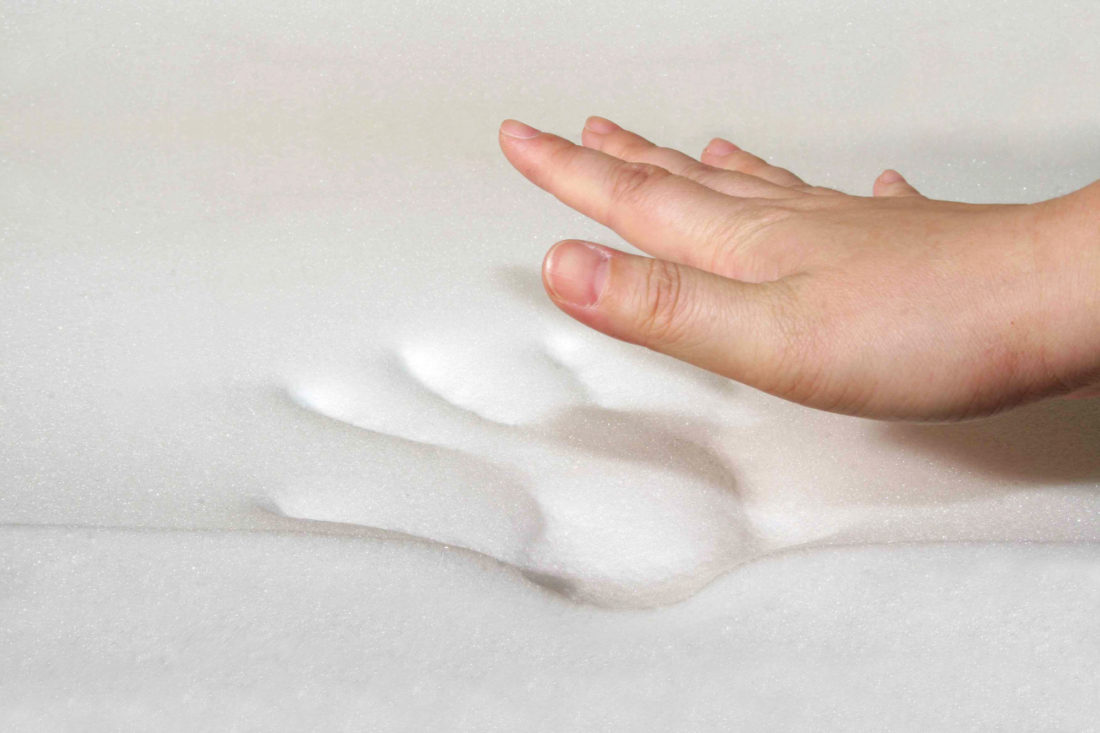 Yick.
Yick.
It’s time to buy a mattress: your least favorite part of moving into a new place. Your back is killing you, and you’ve heard great things about memory foam mattresses, but you have a big question: How does memory foam work?
In this sweet and simple article, I’ll introduce you to memory foam and explain why it works so well. Then, I’ll help you get set to pick out the perfect mattress.
You’ll have everything you need to get the sleep you’ve been dreaming of.
Table of Contents
How Does Memory Foam Work?
Memory foam essentially works the way it sounds: it’s a foam material (“visoelastic polyeurethane,” to be specific) that molds around your sleeping body and remembers your sleeping posture.
The foam is composed of open cells that allow air to circulate and create a cushion around you.
The cells have a dense structure, meaning they are sturdy and create a thick interior for the foam to support weight.
Where a spring mattress has a limited number of springs to support your weight, the foam cell distribution makes the cushion broader and more comfortable.
The term “visoelastic” means that, unlike regular polyeurethane foam, memory foam mattresses are fluid enough (viscuous) and dense enough (elastic) to support weight and create resistance.
Memory foam is strong enough to receive the pressure from your body and, rather than collapse, support your frame while keeping your body’s impression.
Fun fact: NASA developed the foam chemical combination for use in space to improve seat cushioning and crash protection for pilots.
Three Types of Memory Foam
You have three tailor-made options to choose from:
Traditional
Traditional memory foam molds around your sleeping body, bears weight durably over time, and softens around you to support your frame.
(Sometimes these can overheat sensitive sleepers: if so, consider air cool or a cool mattress topper.)
Air Cool
If you get overheated at night and want the comfort of memory foam, you should definitely consider air cool or gel cool memory foam.
Air cool memory foam decreases the density of traditional memory foam by a utilizing less-dense cell mattress structure (technology called “open cell”). This means air can vent throughout the mattress and you can stay cool.
Gel Cool
Gel cool memory foam incorporates gel beads into the mattress structure to keep the mattress cool. They have the same open cell concept as air cool mattress, but use gel beads instead.
1. Choose Your Perfect Mattress Type
Air cool? Gel cool? Traditional? Know thyself and thy needs.
If you have a partner, you can provide one another with helpful information about mutual sleeping patterns, and you can compare preferences. If not, try a memory recall of what has contributed to your best nights’ sleep . . . and to your worst ones.
2. Select Your Best Options
You’ve assembled your criteria and picked your mattress type. Time to test some models.
Reviews are a great way to scope out what works and what doesn’t with your preferred mattress type and the easiest way to pick one up. Customers give real-world, honest feedback about the product you intend to buy.
You can get reviews for just about anything, like mattress in a box reviews.
3. Bring Your Mattress Home
It’s time to put your decision making to the test.
Make sure to let your mattress expand for about 24 hours before you lie down on it. This helps the mattress lengthen to its full size to give you the optimal fit for your sleeping experience.
Check Out a Memory Foam Mattress
Now that you’ve answered your question “how does memory foam work?”, you can get set to pick out the memory foam mattress that’s just right for your needs.
It’s a simple process with a reward that lasts more than a thousand nights. (That’s an Aladdin reference, in case you’re keeping track.)
Try shopping for a memory foam mattress to see the difference comfort makes.







